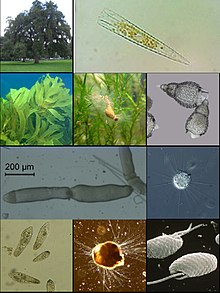Diaphoretickes
| Diaphoretickes | |
|---|---|

| |
| Scientific classification | |
| Domain: | Eukaryota |
| Clade: | Diaphoretickes Adl et al., 2012 |
| Subtaxa | |
|
See cladogram | |
| Synonyms | |
| |
Diaphoretickes (/ˌdaɪ.əfəˈrɛtɪkiːz/ DY-ə-fə-RET-i-keez) is a major group of eukaryotic organisms, with over 400,000 species. The majority of the earth's biomass that carries out photosynthesis belongs to Diaphoretickes.[1]
Phylogeny
[edit]In 2012 the term Diaphoretickes was coined, and received the following phylogenetic definition:
The most inclusive clade containing Bigelowiella natans Moestrup & Sengco 2001 (Rhizaria), Tetrahymena thermophila Nanney & McCoy 1976 (Alveolata), Thalassiosira pseudonana Cleve 1873 (Stramenopiles), and Arabidopsis thaliana (Linnaeus) Heynhold, 1842 (Archaeplastida), but not Homo sapiens Linnaeus 1758 (Opisthokonta), Dictyostelium discoideum Raper 1935 (Amoebozoa) or Euglena gracilis Klebs 1883 (Excavata). This is a branch-based definition in which all of the specifiers are extant.[2]
The placement of Hemimastigophora is uncertain. Some studies find it nested within the clades of Diaphoretickes, as the best supported hypothesis[3] or a less-supported one.[4] Others find it to be the sister group of all other Diaphoretickes,[4] which under the branch-based definition falls within Diaphoretickes.[2]
Diaphoretickes includes the following groups:
| Diaphoretickes | |
In 2024, Hemimastigophora and Provora were placed as sister to Diaphoretickes, together with Meteora.[5]
Taxonomic history
[edit]Diaphoretickes was identified by Burki et al. (2008) as the "plants+HC+SAR megagroup".[6] because it included plants (Archaeplastida), haptophytes, cryptomonads, and stramenopiles, alveolates, and rhizarians. Diaphoretickes has been called the SAR/HA Supergroup or "Corticata with Rhizaria".[7] According to this description, it includes most of the species engaging in photosynthesis, except for the Euglenozoa and Cyanobacteria. It includes all Bikonts that are not excavates. The name "Corticata" comes from Cavalier-Smith's hypothesis about the common origin of the cortical alveoli of glaucophytes and alveolates.[8] The megagroup was previously described as the sum of Archaeplastida, Rhizaria, and chromalveolates.[9] However, this description is obsolete, largely due to the discovery that Chromalveolata, a refinement of Chromista, is not monophyletic.[10][11]
References
[edit]- ^ Bar-On YM, Phillips R, Milo R (June 2018). "The biomass distribution on Earth". Proceedings of the National Academy of Sciences of the United States of America. 115 (25): 6506–6511. doi:10.1073/pnas.1711842115. PMC 6016768. PMID 29784790.
- ^ a b Adl SM, Simpson AG, Lane CE, Lukeš J, Bass D, Bowser SS, et al. (September 2012). "The revised classification of eukaryotes". The Journal of Eukaryotic Microbiology. 59 (5): 429–493. doi:10.1111/j.1550-7408.2012.00644.x. PMC 3483872. PMID 23020233.
- ^ Yazaki, Euki; Yabuki, Akinori; Imaizumi, Ayaka; Kume, Keitaro; Hashimoto, Tetsuo; Inagaki, Yuji; et al. (2022). "The closest lineage of Archaeplastida is revealed by phylogenomics analyses that include Microheliella maris". Open Biology. 12 (210376): 210376. doi:10.1098/rsob.210376. PMC 9006020. PMID 35414259.
- ^ a b Lax, Gordon; Eglit, Yana; Eme, Laura; Bertrand, Erin M.; Roger, Andrew J.; Simpson, Alastair G.B. (14 November 2018). "Hemimastigophora is a novel supra-kingdom-level lineage of eukaryotes". Nature. 564 (7736): 410–414. Bibcode:2018Natur.564..410L. doi:10.1038/s41586-018-0708-8. PMID 30429611. S2CID 205570993.
- ^ Torruella, Guifré; Galindo, Luis Javier; Moreira, David; López-García, Purificación (2024-05-15), Phylogenomics of neglected flagellated protists supports a revised eukaryotic tree of life, doi:10.1101/2024.05.15.594285, retrieved 2024-08-25
- ^ Burki F, Shalchian-Tabrizi K, Pawlowski J (August 2008). "Phylogenomics reveals a new 'megagroup' including most photosynthetic eukaryotes". Biology Letters. 4 (4): 366–369. doi:10.1098/rsbl.2008.0224. PMC 2610160. PMID 18522922.
- ^ Cavalier-Smith T, Chao EE, Snell EA, Berney C, Fiore-Donno AM, Lewis R (December 2014). "Multigene eukaryote phylogeny reveals the likely protozoan ancestors of opisthokonts (animals, fungi, choanozoans) and Amoebozoa". Molecular Phylogenetics and Evolution. 81: 71–85. doi:10.1016/j.ympev.2014.08.012. PMID 25152275.
- ^ Cavalier-Smith T (January 2003). "Protist phylogeny and the high-level classification of Protozoa". European Journal of Protistology. 39 (4): 338–348. doi:10.1078/0932-4739-00002.
- ^ Hampl V, Hug L, Leigh JW, Dacks JB, Lang BF, Simpson AG, Roger AJ (March 2009). "Phylogenomic analyses support the monophyly of Excavata and resolve relationships among eukaryotic "supergroups"". Proceedings of the National Academy of Sciences of the United States of America. 106 (10): 3859–3864. Bibcode:2009PNAS..106.3859H. doi:10.1073/pnas.0807880106. PMC 2656170. PMID 19237557.
- ^ Burki, Fabien; Shalchian-Tabrizi, Kamran & Pawlowski, Jan (2008). "Phylogenomics reveals a new 'megagroup' including most photosynthetic eukaryotes". Biology Letters. 4 (4): 366–369. doi:10.1098/rsbl.2008.0224. PMC 2610160. PMID 18522922.
- ^ Kim, E.; Graham, LE (Jul 2008). Redfield, Rosemary Jeanne (ed.). "EEF2 analysis challenges the monophyly of Archaeplastida and Chromalveolata". PLOS ONE. 3 (7): e2621. Bibcode:2008PLoSO...3.2621K. doi:10.1371/journal.pone.0002621. PMC 2440802. PMID 18612431.

